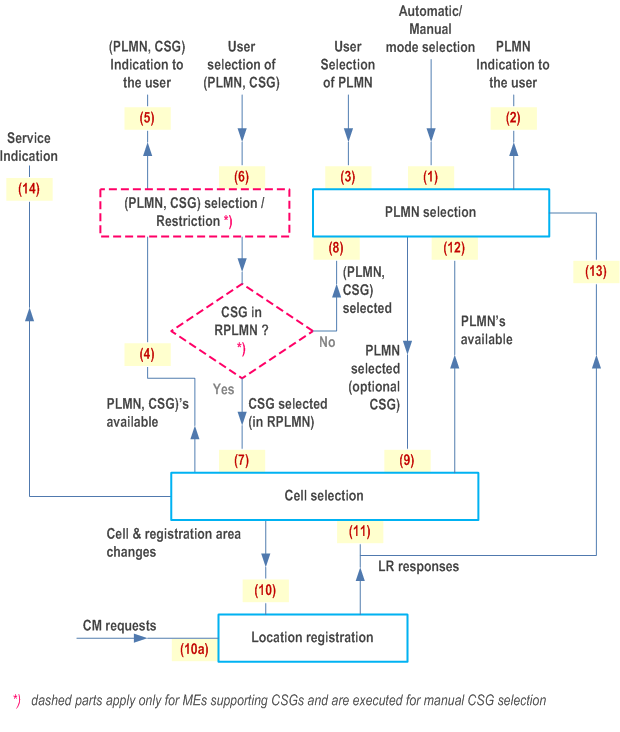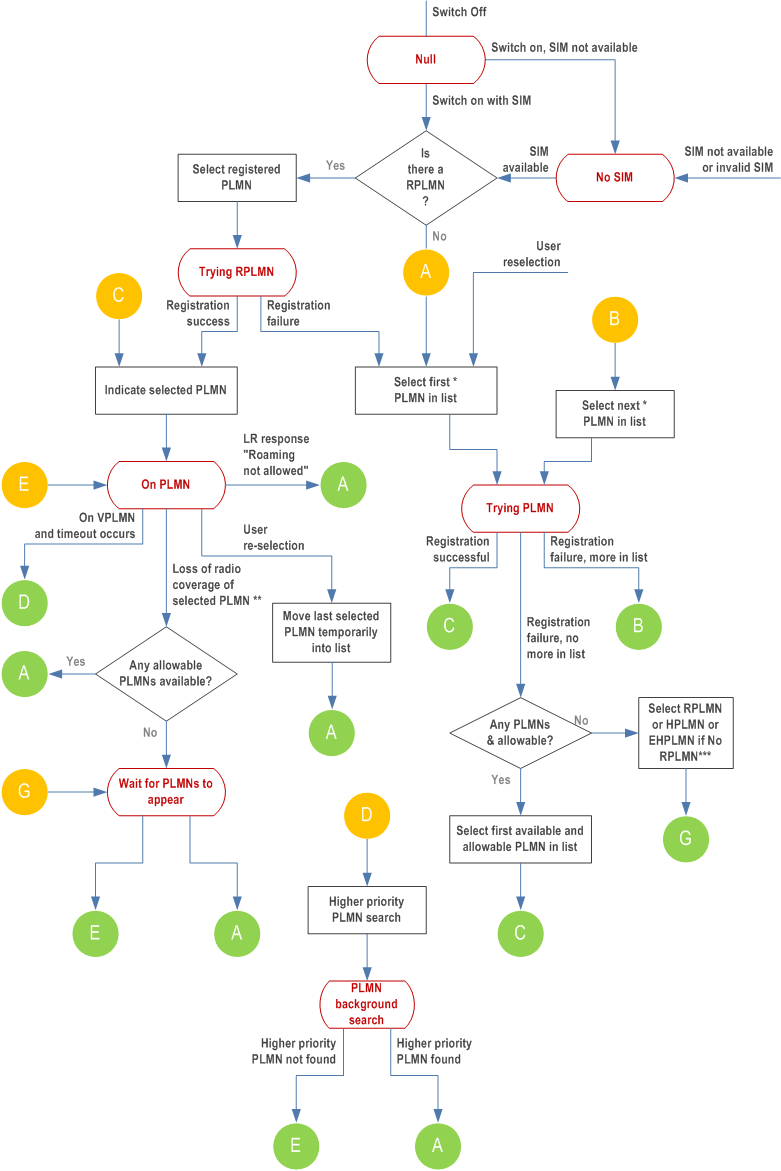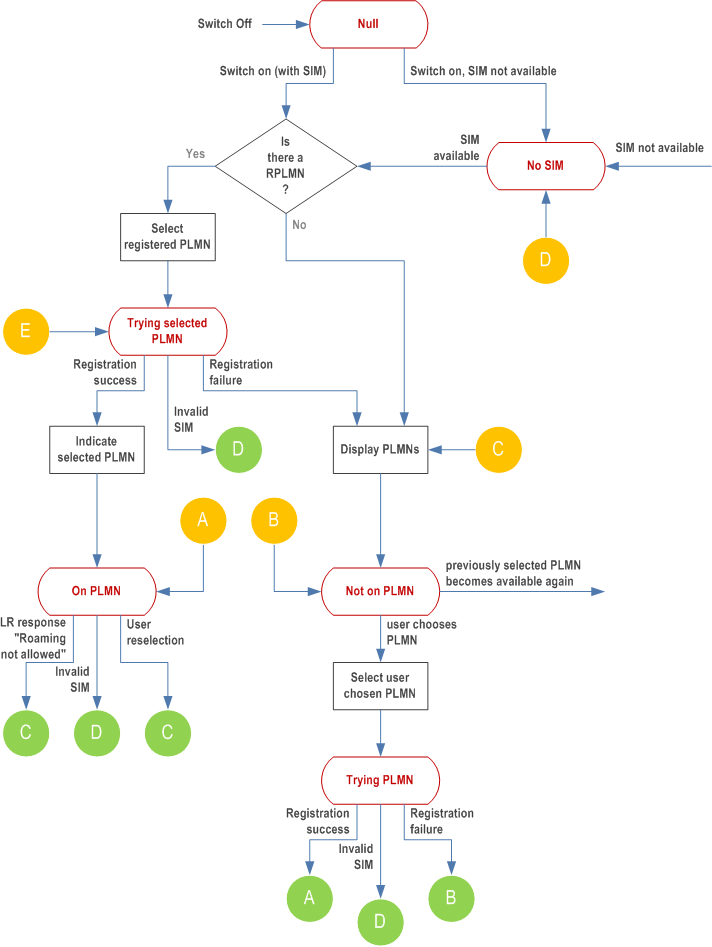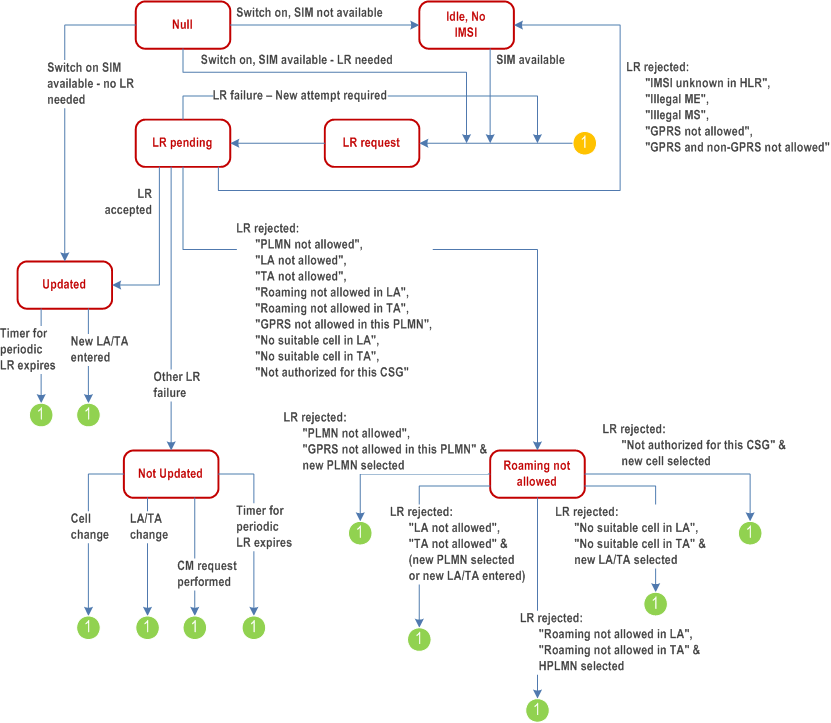Content for TS 23.122 Word version: 19.1.0
5 Tables and Figures
6 MS supporting access technologies defined both by 3GPP and 3GPP2
6.1 General
...
...
5 Tables and Figures p. 90
| Location Registration Task State | Registration Status | Registered PLMN is |
|---|---|---|
| Updated | Successful | Indicated in the stored registration area identity |
| Idle, No IMSI | Unsuccessful | No registered PLMN (3) (4) |
| Roaming not allowed: | ||
|
a)
PLMN not allowed | Unsuccessful | No registered PLMN (4) |
|
b)
LA not allowed, or TA not allowed | Indeterminate (1) | No registered PLMN |
|
c)
Roaming not allowed in this LA, or Roaming not allowed in this TA | Indeterminate (2) | No registered PLMN (4) |
|
d)
No suitable cells in location area, or No suitable cells in tracking area | Indeterminate (5) | No registered PLMN |
|
e)
Not authorized for this CSG | Indeterminate (6) | No registered PLMN |
| Not updated | Unsuccessful | No registered PLMN (4) |
|
1)
NOTE 1:
The MS will perform a cell selection and will eventually either enter a different state when the registration status will be determined, or fail to be able to camp on a new cell, when registration status will be unsuccessful.
2)
The MS will select the HPLMN (if the EHPLMN list is not present or is empty) or an EHPLMN (if the EHPLMN list is present) if in automatic mode and will enter Automatic Network Selection Mode Procedure of clause 4.4.3.1.1. If in manual mode, the MS will display the list of available PLMNs and follow the Manual Network Selection Mode Procedure of clause 4.4.3.1.2 If the appropriate process does not result in registration, the MS will eventually enter the limited service state.
3)
An MS may have different update states for GPRS and non-GPRS. A PLMN is registered when at least one of both update states is updated.
4)
The stored list of equivalent PLMNs is invalid and can be deleted.
5)
The MS will attempt registration on another LA or TA of the same PLMN, or equivalent PLMN if available.Otherwise it will enter either the Automatic Network Selection Mode procedure of clause 4.4.3.1.1 or follow the Manual Network Selection Mode procedure of clause 4.4.3.1.2. If the appropriate process does not result in registration, the MS will eventually enter the limited service state.
6)
The MS will attempt registration on another cell of the same PLMN, or equivalent PLMN if available.Otherwise it will enter either the Automatic Network Selection Mode procedure of clause 4.4.3.1.1 or follow the Manual Network Selection Mode procedure of clause 4.4.3.1.2. If the appropriate process does not result in registration, the MS will eventually enter the limited service state.
MSs capable of GPRS and non-GPRS services may have different registration status for GPRS and for non-GPRS.
NOTE 2:
The registered PLMN is determined by looking at the stored registration area identity and stored location registration status.
|
||
| Location Registration Task State | New LR request when | Normal Calls Supported (1) | Paging responded to | |||
|---|---|---|---|---|---|---|
| Changing Cell | Changing registration area | Changing PLMN | Other | |||
| Null (4) | No | Yes | Yes | No | No | No |
| Updated, (5) | No | Yes | Yes | (2) | Yes | Yes |
| Idle, No IMSI (7) | No | No | No | No | No | No |
| Roaming not allowed: | ||||||
|
a)
Idle, PLMN not allowed |
No | No | Yes | No | No | Optional if with IMSI |
|
b)
Idle, LA not allowed, or TA not allowed |
No | Yes (6) | Yes | No | No | Optional if with IMSI |
|
c)
Idle, Roaming not allowed in this LA, or Roaming not allowed in this TA |
No | Yes 6,8) | Yes | No | No | Optional if with IMSI |
|
d)
No suitable cells in location area, or No suitable cells in tracking area |
No | Yes (6,8) | Yes | No | No | Optional if with IMSI |
|
e)
Not authorized for this CSG |
No | Yes (6,8) | Yes | No | No | Optional if with IMSI |
| Not updated | Yes | Yes | Yes | (2) & (3) | (3) | Yes if with IMSI |
|
1)
Emergency calls may always be made, subject to access control permitting it.
2)
A new LR is made when the periodic registration timer expires.
3)
If a normal call request is made, an LR request is made. If successful the updated state is entered and the call may be made.
4)
The MS is in the null state from switch on until it has camped on a cell and either made an LR attempt or decided that no LR attempt is needed.
5)
In this state, IMSI detach is performed if the MS is deactivated and the BCCH indicates that IMSI attach/detach shall be used. An LR request indicating IMSI attach is performed if the MS is activated in the same registration area in which it was deactivated while being in this state.
6)
An MS shall not perform a new LR when the new routing area is part of an LA or TA contained in any of the lists "forbidden location areas for roaming", "forbidden tracking areas for roaming", "5GS forbidden tracking areas for roaming", "forbidden location areas for regional provision of service", "forbidden tracking areas for regional provision of service", "5GS forbidden tracking areas for regional provision of service" or the new cell is a CSG cell which is not part of any of the lists "Allowed CSG list", "Operator CSG list". The MS shall not perform a LR on a satellite NG-RAN cell or a satellite E-UTRAN cell if it fulfils the conditions related to the list of "PLMNs not allowed to operate at the present UE location" as defined in clause 3.1, i.e. if it is not considered as candidate for PLMN selection.
7)
The conditions in which the GPRS and/or non-GPRS registration status "Idle, No IMSI" is entered are specified in clause 4.3.3.
8)
An MS shall perform a LR if it has entered a registration area whatever the registration area stored in the MS.
|
||||||

The individual steps are the following (they are not necessarily executed in the number sequence):
Possible sequences of steps are e.g.:
(1)
The PLMN selection mode is set (e.g. by the user via the user interface or by AT command).
(2)
The list of available PLMNs is presented to the user, according to the rules given in clause 4.4.3.1.2.
3)
In manual PLMN selection mode the user selects from the available PLMNs.
(4)
If the MS supports CSGs, the list of available PLMNs and CSGs, together with an indication as to which of the available CSGs is in the Allowed or Operator CSG list, is presented to the user upon request. The detailed rules are defined in clause 5.5.4 of TS 22.220.
(5)
Only for MSs supporting CSGs: when camping on a cell, the available CSGs (with PLMN information) are conveyed to the CSG selection/restriction procedure (see clause 3.1A).
(6)
Only for MSs supporting CSGs: in manual CSG selection mode the user selects from the available CSGs.
(7)
Only for MSs supporting CSGs: if the selected CSG is associated with the RPLMN, the MS performs selection of a cell belonging to this CSG.
(8)
Only for MSs supporting CSGs: if the selected CSG is associated with a PLMN different from the RPLMN, the MS enters the PLMN selection process and performs the parts applicable after manual selection of a PLMN.
(9)
After it has selected a PLMN, the MS performs selection of a cell belonging to this PLMN; this selection is additionally restricted by the selected CSG, if the PLMN selection was triggered by a manual CSG selection.
(10)
After having selected a new cell and the registration area has changed, the MS shall enter the LR process (see Figure 3).
(10a)
An MS's CM requests may lead to a registration request.
(11)
If the LR is not successful, and if the cause received from the network does not exclude the RPLMN, the MS performs another cell selection (i.e. cell re-selection) within the RPLMN.
(12)
The information on available PLMNs, as detected by the cell selection process from detectable broadcast information, is made available to the PLMN selection process.
(13)
If the LR is not successful, and if the cause received from the network excludes the RPLMN, the MS performs PLMN selection.
(14)
The positive result of cell selection (suitable cell and in updated state, or in connected mode having been camped on a suitable cell) and location registration (updated, for MSs capable of services requiring registration) is indicated to the user.
1)
1 → 2 → 3 → 9 → 10 → 11 (manual PLMN selection, MS is not CSG capable)
2)
1 → 9 → 4 → 5 → 6 → 8 → 9 → 10 → 11 (automatic PLMN selection, MS is CSG capable, manual CSG selection);

*
"List" consists of points i) to v) as defined in clause 4.4.3.1.1 except in case of a user reselection in which case "list" consists of points i) to vi) as defined in clause 4.4.3.2.1
**
Includes effective loss of coverage due to LAs/TAs being forbidden in all potentially suitable cells
***
HPLMN (if the EHPLMN list is not present or is empty) or EHPLMN (if the list is present)


6 MS supporting access technologies defined both by 3GPP and 3GPP2 |R8| p. 96
6.1 General p. 96
An MS that supports access technologies defined both by 3GPP and 3GPP2 (see TS 31.102) shall consider all supported access technologies in all supported bands when performing PLMN selection.
The goal of the PLMN selection process for such a multi mode MS is to find the highest priority PLMN and to attempt to register to it.
A multi mode MS shall follow the requirements in the present document for the PLMN selection procedures across both 3GPP and 3GPP2 access technologies. Additionally, the MS shall follow the requirements of the present document in its signalling procedures towards any 3GPP network. If the common PLMN selection procedure leads to selection of a 3GPP2 network, then the MS shall follow 3GPP2 specifications in meeting any 3GPP2 specific system selection constraints and in all signalling procedures towards the 3GPP2 network.
While registered to VPLMN via 3GPP2 access, the MS shall follow the 3GPP2 specifications for scan of higher priority PLMNs. Additionally to the requirements specified for 3GPP2 system, a multi mode MS while registered to a 3GPP2 VPLMN shall follow the requirements specified in clause 4.4.3.3.